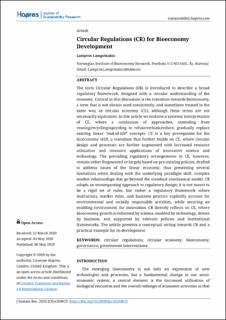| dc.description.abstract | The term Circular Regulations (CR) is introduced to describe a broad regulatory framework, designed with a circular understanding of the economy. Central in this discussion is the transition towards bioeconomy, a term that is not always used consistently, and sometimes treated in the same way as circular economy (CE), although these terms are not necessarily equivalent. In this article we endorse a systemic interpretation of CE, where a continuum of approaches, extending from reusing/recycling/upcycling to refuse/rethink/reduce, gradually replace existing linear “end-of-life” concepts. CE is a key prerequisite for the bioeconomy shift, a transition that further builds on CE, where circular design and processes are further augmented with increased resource utilization and intensive applications of innovative science and technology. The prevailing regulatory arrangements in CE, however, remain either fragmented or largely based on pre-existing policies, drafted to address issues of the linear economy, thus presenting several limitations when dealing with the underlying paradigm shift: complex market relationships that go beyond the standard neoclassical model. CR adopts an encompassing approach to regulatory design; it is not meant to be a rigid set of rules, but rather a regulatory framework where institutions, market rules, and business practice explicitly account for environmental and socially responsible activities, while securing an enabling environment for innovation. CR directly reflects on CE, where bioeconomy growth is informed by science, enabled by technology, driven by business, and supported by relevant policies and institutional frameworks. The article presents a conceptual setting towards CR and a practical example for its development. | en_US |

